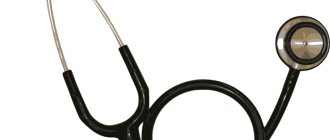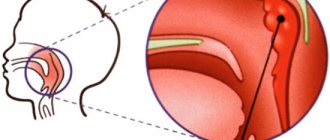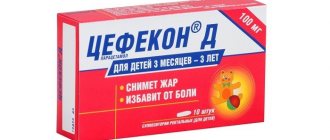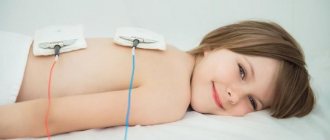general information
"Vibrocil" is a medicine for the treatment of rhinitis of viral and allergic origin. Its formula includes two components:
- phenylephrine (2.5 mg/1 ml) - affects capillaries, leading to their narrowing, period of action - 4-6 hours;
- Dimetindene maleate (250 mcg/1 ml) is a histamine receptor blocker that relieves itching and swelling.
"Vibrocil" is produced in several forms. Children under one year of age are prescribed drops in 15 ml bottles. They look like a yellowish liquid with a lavender scent.
"Nazivin" is a drug used in the treatment of colds. The main substance is oxymetazoline, a vasoconstrictor that lasts longer than 12 hours. In infants, a drop concentration of 0.01% is used (0.1 mg of the active component in 1 ml of medication). They are available in 10 ml bottles. They look like a clear, colorless liquid with a slight odor.
"Vibrocil" and "Nasivin" are sold without a prescription, but in children under one year of age and newborns they should only be used as prescribed by a doctor. It is recommended to store the drops in a dark, cool place.
Questions for the doctor
From what age can it be used?
According to the instructions, the drug is contraindicated in children under 1 year of age, but despite this, it is also successfully used to treat infants.
You can start using Vibrocil to combat it only with the permission of your pediatrician.
What is better Nazivin or Vibrocil?
Vibrocil is a complex drug that effectively eliminates swelling and helps with allergies. Nazivin contains only a vasoconstrictor active substance, so it can only temporarily eliminate swelling and associated nasal congestion.
But the effect of Nazivin is more intense and lasts much longer (on average about 10–12 hours). Therefore, in different cases, each of these medications will be a more profitable purchase.
Vibrocil or Rinofluimucil?
Both drugs are classified as combination drugs. But if Vibrocil only temporarily eliminates the unpleasant symptoms of colds and allergies, then Rinofluimucil has an anti-inflammatory effect and at the same time thins viscous mucus, thereby facilitating its removal.
After using Rinofluimucil, the formation of less discharge and faster recovery are observed.
Therefore, for various acute respiratory infections and sinusitis, especially those accompanied by purulent processes, the use of Rinofluimucil is preferable.
But this drug is contraindicated in children under 2 years of age and is much more expensive than Vibrocil. Therefore, for mild acute respiratory infections without mucus mixed with pus, using Vibrocil is sufficient.
How many days can you drip?
Self-administration of any vasoconstrictor drug is permitted for no more than 5–7 days. Further use is carried out exclusively as prescribed by a doctor.
Since it can lead to the development of the so-called “ricochet” effect or medicinal rhinitis, that is, addiction to the active substance and the persistence of swelling even after the root causes of its appearance have been eliminated.
Features of the action
The instructions indicate that the preparations “Vibrocil” and “Nasivin” contain vasoconstrictor components - phenylephrine and oxymetazoline, respectively. They have a similar effect - they stimulate the receptors of the nasal mucosa, leading to contraction of small blood vessels. As a result:
- swelling of epithelial cells decreases;
- mucus secretion decreases;
- the nasal passages are cleared;
- breathing becomes easier.
The difference between phenylephrine and oxymetazoline is the period of action - the effect of the first lasts 4-6 hours, and the second - 12 hours. Substances with a short duration of action are not typically used in pediatric practice, but phenylephrine is an exception.
Of all the vasoconstrictors, it has the least effect on the cardiovascular system. Treatment of children under one year of age with it is considered relatively safe. Another advantage of phenylephrine is low trauma to the nasal mucosa - it does not reduce the activity of the epithelium.
The second component of Vibrocil drops, dimethindene, has an antiallergic effect: it relieves nasal swelling and reduces the secretion of mucus caused by allergen entering the body.
Young children are very sensitive to various aerosol irritants, and during acute respiratory viral infections this susceptibility increases. The combination of a vasoconstrictor and antihistamine component provides a more pronounced effect for rhinitis.
“Nasivin” also helps children with allergic rhinitis, but only due to its effect on blood vessels, it does not affect histamine receptors. Its advantage is long intervals between instillations.
Mode of application
Before administering the drug, you should rinse your nasal passages with any saline solution.
As such, you can choose special systems, for example Aquamaris and Dolphin, or use an affordable, but no less, solution of table salt prepared at home and improvised means.
The medicine is administered with the head thrown back. Moreover, this position must be maintained for another 10–15 seconds after administration.
Like all vasoconstrictors, Vibrocil nasal drops should not be used for more than a week.
In the opposite case, there is a high risk of addiction, manifested by the constant persistence of swelling until new doses of the medication are administered.
If the patient’s condition does not improve within a week, especially if after temporary relief it has sharply worsened, it is imperative that rhinitis is of a bacterial nature or threatens serious complications.
In such situations, the doctor may prescribe an antibiotic. As a rule, preference is given to medications for topical use, for example, Isofra or Polydex.
Indications and contraindications
The instructions for the “Nazivin” and “Vibrocil” products inform you that they can be used in children under one year of age and newborns in such cases as:
- acute rhinitis – bacterial, viral and allergic;
- vasomotor rhinitis;
- sinusitis;
- otitis media – to eliminate mucus stagnation in the Eustachian tube;
- preparation for various manipulations in the field of ENT organs;
- Relieving swelling after surgery.
In what cases is a vasoconstrictor drug contraindicated? Basic recommendations:
- general – intolerance to components, atrophic rhinitis;
- “Nazivin” – angle-closure glaucoma;
- "Vibrocil" - during pregnancy, treatment with drugs that suppress monoamine oxidase.
In addition, children with diabetes, hypertension and thyroid dysfunction should take Nazivin drips with caution - according to an individual regimen developed by the doctor.
Another significant point is the choice of concentration of the active substance. In children under one year old, only Vibrocil and Nazivin 0.01% drops can be used. Nasal spray is contraindicated at this age: it can lead to the release of mucus into the Eustachian tube and the development of inflammation.
Indications for use: when is it prescribed? Description
Instructions for use recommend using the medication for the following types of rhinitis:
- acute viral and bacterial nature;
- allergic, in particular hay fever;
- chronic, including vasomotor.
It is also prescribed for:
- acute and chronic forms of sinusitis and other types of sinusitis, with adenoids;
- inflammation of the middle ear (otitis);
- preparation for diagnostic or surgical interventions on the ENT organs or after them to eliminate postoperative swelling.
In general, the list of what the medicine helps with is quite extensive. But it must be taken into account that it does not produce a therapeutic effect, but only temporarily eliminates the symptoms of the disease.
How to use?
The instructions contain the following scheme for using Nazivin:
- for newborns (up to 4 weeks) – 1 drop in each stroke;
- up to a year – 1-2 drops.
Regularity – 2-3 times a day.
The dosage of “Vibrocil” for infants is 1 drop in one nostril 3-4 times a day. The duration of therapy for both drugs is no more than 7 days, but it is better when it does not exceed 3-5 days. In this case, the likelihood of addiction is reduced.
Drops in children are used not planned, but symptomatically: if the required time interval has passed and the nose is breathing normally, there is no need to instill them. It is important not to exceed the dosage and frequency of drug administration, otherwise the risk of side effects increases.
Before instilling drugs, the baby's nasal passages must be cleared of mucus with saline solution and an aspirator. Instructions for administering the medicine:
- Lay the baby on his back.
- Turn its head to the right, drip the solution into the right nasal passage, and squeeze it.
- Wait 1-2 minutes and repeat all manipulations with the left nostril.
For the smallest children, you can drip the product onto cotton pads and place them one by one in the nasal passages.
General description and pharmacological action
Vibrocil is a drug that has a vasoconstrictor and antihistamine effect, it is an effective remedy against allergies, which allows you to cope with unpleasant ones and significantly improves the quality of life.
One of the advantages is its wide application possibilities: Vibrocil is not contraindicated for children under one year old, as well as for children of other ages. This is a safe and effective remedy.
This is a combination drug whose active ingredients are Dimetindene and Phenylephrine. The first of them has an anti-allergenic effect, while it does not impair the functioning of the ciliated epithelium of the nasal cavity.
Phenylephrine has a vasoconstrictor effect and reduces swelling of the mucous membrane, so it helps fight the manifestations of rhinitis.
The combination of these substances has a complex effect and allows you to effectively combat allergy symptoms.
Vibrocil is available in three dosage forms:
- The gel is a homogeneous mass of a pale yellow hue with a lavender aroma.
- The spray is a yellowish liquid that is used by irrigating the nasal mucosa. Gel and spray can be used for children aged 6 years and older.
- – colorless or yellowish transparent solution with the aroma of lavender. Drops are a medicine for infants under 1 year of age. This is one of the few drugs that can be taken even at this age.
An additional use of Vibrocil is the preparation of the nasal cavity for surgical interventions. It is also sometimes used to relieve swelling after various medical procedures.
Directions for use and dosage
Vibrocil, like other antiallergic drugs, is prescribed only by a doctor. Like all other medications, it has its risks, and it is better not to take risks by self-medicating.
Depending on the age of the child and the form of release of the drug, the daily dose is determined:
- Gel is the newest form of release. The child's nasal cavity must first be cleared of it, after which a large amount is injected into the nostrils to the maximum depth. It is permissible to use the gel no more than 4 times per day, with the last time the gel is used immediately before bedtime. This will free the child from feeling for the whole night and ensure a comfortable sleep. The gel can be used by both children over 6 years old and adults; it is an excellent product for the whole family.
- – a form of the drug for children. Before use, you need to clean the nasal cavity, after which the child needs to tilt his head back, and the drug is instilled into each nostril. The number of drops is determined by age: children under one year old - 1 drop, children under 6 years old - 1-2 drops, over 6 years old and adults - 3-4 drops. The medicine should be used before feeding. The drug is equipped with a built-in pipette, which simplifies its use.
- Vibrocil spray is the most convenient form of use. It ensures uniform irrigation of the nasal cavity, so the medicine begins to act faster and gives the desired effect. Before use, the nasal cavity is cleaned, the tip of the spray is inserted into the nostril and sprayed 1-2 times. Re-use is possible after 6 hours.
The drug has only a local effect and quickly produces an effect. However, it must be taken into account that if it is used for more than one week, it can become addictive, and the body will refuse to fight allergic rhinitis on its own. To prevent this from happening, it is necessary to choose the right analogues and look for other ways to combat allergies. Vibrocil is most often used not as a primary, but as an auxiliary remedy: it eliminates symptoms, but only slightly helps eliminate their cause.
Contraindications
This medicine has virtually no side effects. Only in some cases, excessive sensitivity to the components of the drug is possible, which can be manifested by a feeling of dryness or burning.
However, there are several cases when the use of Vibrocil is contraindicated:
- Heart disease, arrhythmia, hypertension. If a child has heart defects or other serious diseases, prior medical consultation is necessary before using any medications.
- Decreased sensitivity of the nasal cavity. With chronic rhinitis, the mucous membrane may gradually lose sensitivity to medications, in which case the use of drops and sprays does not make sense. It is necessary to consult an allergist who will select a comprehensive individual treatment.
- In some cases, diabetes mellitus becomes a contraindication. In any case, the use of antiallergy medications should be discussed with a specialist.
- For adult patients, pregnancy and lactation are contraindications. An antiallergenic drug can have a negative effect on an unformed body.
- Thyroid diseases. Hormonal imbalances are also a contraindication; in this case, it is necessary to look for other methods of combating allergies.
Almost no negative effects have been identified in case of an overdose of the drug. In rare cases, when swallowing the medicine, the patient may notice a feeling of drowsiness and fatigue or, on the contrary, tachycardia and increased excitability.
Side effects
The active ingredients of “Vibrocil” and “Nazivin” are practically not absorbed into the bloodstream and do not have a significant effect on the body. Both remedies can cause a burning and dry feeling in the nose, as well as sneezing. Vibrocil does not cause any other negative reactions in children. The list of side effects of Nazivin is wider:
- tachycardia;
- hypertension;
- sleep disturbance;
- headache;
- nausea.
The instructions inform you that such reactions occur only with prolonged use and overdoses.
A significant overdose of oxymetazoline can lead to dysfunction of the gastrointestinal tract, hyperthermia, abnormal heart rhythm, pulmonary edema, central nervous system depression and even cardiac arrest. Exceeding the norm of phenylephrine is fraught with nausea, vomiting, abdominal pain and rapid heartbeat.
It is not recommended to combine treatment with Vibrocil and Nazivin with taking:
- monoamine oxidase inhibitors;
- tricyclic antidepressants;
- antihypertensive drugs.
Release form of the drug "Vibrocil"
This medicine is available in three forms: nasal drops, spray, gel.
Nasal drops
Sold in dark glass bottles of 15 ml. For ease of use, the bottle has a screw-on pipette cap.
Nasal spray
The LDPE bottle contains 10 ml of the drug. The container has a sprayer and a screw-on HDPE cap, which is equipped with a first-opening control system.
Nasal gel
12 g of the drug is placed in aluminum tubes with a narrow tip and a plastic cap.










